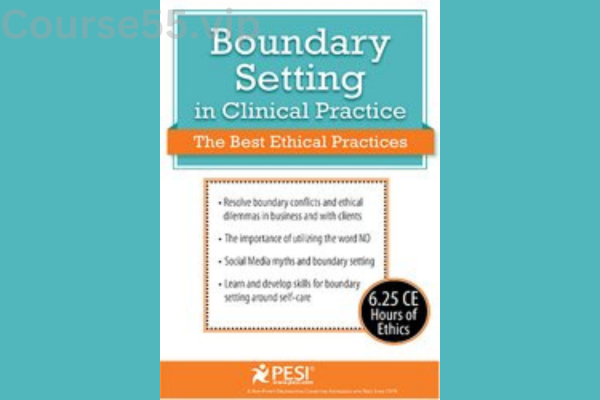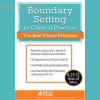Boundary Setting in Clinical Practice: The Best Ethical Practices By Latasha Matthews – PESI
$199.00 Original price was: $199.00.$23.10Current price is: $23.10.
Boundary Setting in Clinical Practice: The Best Ethical Practices by Latasha Matthews – Digital Download!

Boundary Setting in Clinical Practice: The Best Ethical Practices By Latasha Matthews – PESI
Overview

Boundary Setting in Clinical Practice: The Best Ethical Practices by Latasha Matthews
In the complex field of healthcare and therapy, establishing clear boundaries is crucial to cultivating trust and maintaining ethical standards. Latasha Matthews’ work, Boundary Setting in Clinical Practice: The Best Ethical Practices, serves as a comprehensive guide designed to assist healthcare professionals in navigating the ethical challenges related to boundaries. Matthews emphasizes the importance of setting clear boundaries to protect both clients and practitioners, ensuring professional integrity is upheld. This article explores the key elements from Matthews’ guide, providing insights on how boundary setting can improve clinical practice.
Grasping the Concept of Boundaries
Boundaries are fundamental to successful clinical practice. Matthews defines what constitutes appropriate boundaries and highlights that these may differ depending on the context. For instance, the therapist-client relationship can influence what is considered appropriate behavior. A therapeutic alliance built on cooperation might allow for more openness, whereas a more formal context may impose stricter limitations. Cultural factors further complicate boundary setting, as what is considered acceptable varies greatly across cultures.
In clinical practice, recognizing the subtleties of boundaries is vital. For example, in collectivist societies, the distinction between personal and professional interactions may not be as clear-cut, whereas in individualistic cultures, stricter separations are emphasized. Practitioners must be adept at identifying and respecting these cultural norms to ensure that their practices are both ethical and culturally appropriate. This understanding allows healthcare providers to engage more effectively with clients from diverse backgrounds, strengthening the therapeutic bond.
Key Elements of Boundary Setting
Boundary setting involves not only defining professional limits but also understanding the consequences of violating these boundaries. Healthcare providers often face ethical challenges, such as navigating dual relationships, self-disclosure, and client interactions through digital platforms. Each scenario presents unique ethical concerns that require careful reflection to prioritize client well-being and confidentiality.
To clarify, here are some ethical dilemmas and their implications:
| Dilemma | Description | Implications |
|---|---|---|
| Dual Relationships | When a professional holds multiple roles with a client (e.g., friend and therapist). | Conflicts of interest, blurred boundaries, harm risks. |
| Self-Disclosure | Sharing personal details with clients. | Builds rapport but may shift focus away from therapy. |
| Technology Interactions | Communicating with clients through social media, text, etc. | Privacy risks, ethical issues. |
Matthews provides actionable strategies for managing these dilemmas effectively, helping practitioners maintain ethical standards while delivering high-quality care.
Ethical Guidelines
Abiding by a code of ethics is a fundamental aspect of setting boundaries. Matthews stresses the importance of understanding these ethical frameworks, which provide structure and direction for healthcare practitioners. By adhering to a clear code of ethics, clinicians are better equipped to make difficult decisions regarding boundary setting.
Key ethical principles include:
-
Autonomy: Respecting a client’s right to make informed decisions.
-
Beneficence: Acting in the best interest of the client.
-
Nonmaleficence: The obligation to avoid causing harm.
These principles help guide practitioners in making decisions that uphold the trust placed in them by clients. Matthews discusses how these ethical standards facilitate boundary setting and decision-making, allowing healthcare professionals to avoid common mistakes.
Real-World Examples of Ethical Guidelines
To demonstrate the application of these principles in practice, here are some examples:
-
Autonomy: When a client wants to address uncomfortable topics, the therapist must create a safe space while respecting the client’s boundaries.
-
Beneficence: A therapist may suggest additional support services if they believe the client needs further help, ensuring comprehensive care.
-
Nonmaleficence: Maintaining confidentiality, unless there are safety concerns, illustrates the commitment to “do no harm.”
These ethical considerations form the backbone of boundary setting, encouraging practitioners to reflect on their decisions and their potential impact on clients.
Navigating Common Ethical Challenges
Navigating the complexities of clinical relationships often places practitioners in situations that present ethical challenges. Matthews explains that dilemmas can arise from various factors, including dual relationships, self-disclosure, and misuse of technology. These issues can have serious consequences for both the client and the clinician, making it essential to address them effectively.
Dual relationships, for instance, can be especially tricky. The American Psychological Association (APA) advises against dual relationships when they could compromise professional judgment or increase the risk of exploitation. Matthews supports this view, urging clinicians to frequently evaluate their professional roles. To mitigate the risks of dual relationships, practitioners can establish firm boundaries to ensure that personal interactions do not interfere with clinical responsibilities.
Approaches for Managing Ethical Dilemmas
Matthews outlines several strategies to manage ethical dilemmas, including:
-
Seeking Supervision: Consulting with experienced professionals can offer valuable insights and support.
-
Establishing Clear Policies: Clear guidelines for interactions with clients help define professional boundaries.
-
Addressing Issues Quickly: Discussing boundary concerns as they arise fosters transparency and communication.
By applying these strategies, clinicians can better navigate ethical challenges and reaffirm their commitment to client welfare.
Best Practices in Boundary Setting
Matthews highlights the importance of implementing best practices to prevent boundary violations. These practices act as proactive measures to ensure that clinical interactions are guided by ethical principles. One key area of focus is creating clear policies regarding self-referral, social media interactions, and communication outside of scheduled sessions.
Informed consent is crucial in this regard. A thorough consent process can preemptively address potential boundary concerns and clarify expectations for both the client and the clinician. For instance, when explaining how client data will be handled or what to expect during therapy, practitioners can set clear parameters, minimizing the chance of misunderstandings or ethical breaches.
Key Elements of Best Practices
Here are essential components to improve ethical boundary setting:
• Clear Communication: Articulate policies concerning confidentiality, session structure, and relational guidelines.
• Regular Training: Ongoing education about ethics and boundary setting ensures adherence to best practices.
• Documentation: Keeping accurate records of client interactions and agreements supports transparency.
Adopting these best practices strengthens ethical boundaries and enhances the therapeutic experience for clients, ensuring a safe and effective environment.
The Impact of Technology
The rapid advancement of technology has introduced significant challenges to boundary setting in clinical environments. Matthews explores how digital platforms, such as teletherapy and social media, complicate traditional practices and create new ethical concerns. Practitioners must find ways to establish and maintain boundaries while making effective use of these tools.
One of the primary concerns is confidentiality. The use of teletherapy, for example, can make client information more vulnerable to breaches, requiring robust security measures and clear communication regarding privacy expectations.
Strategies for Managing Technology Use
To address the challenges posed by technology, clinicians can implement the following strategies:
• Establish Digital Boundaries: Set clear guidelines on acceptable communication methods (e.g., emails for administrative tasks, therapy conducted on secure platforms).
• Educate Clients: Inform clients about the risks and benefits of technology in therapy, ensuring they understand how their data will be handled.
• Follow Best Practices in Digital Interactions: Utilize encrypted platforms for teletherapy sessions to protect clients’ confidentiality.
By addressing the impact of technology on boundary setting proactively, practitioners can make the most of these tools while maintaining ethical integrity.
Cultural Sensitivity
Culturally aware boundary setting is essential in diverse clinical settings. Different cultures have distinct views on relationships, privacy, and professional interactions. Matthews emphasizes the importance of cultural sensitivity when navigating these complexities.
In certain cultures, there may be a stronger focus on community and family involvement in therapy, challenging traditional views on privacy and confidentiality. In contrast, other cultures may emphasize individualism, advocating for clear separations between personal and professional boundaries. Understanding these cultural dynamics helps practitioners tailor their approaches to meet the diverse needs of their clients, ensuring cultural competence remains central to their practice.
Key Considerations for Cultural Sensitivity
Key aspects to consider for cultural sensitivity in boundary setting:
• Understand Client Backgrounds: Consider how cultural histories influence clients’ expectations regarding boundaries.
• Pursue Ongoing Education: Stay informed about cultural differences and seek relevant training in cultural competence.
• Encourage Open Dialogue: Create space for clients to share their perspectives on boundaries and cultural expectations in therapy.
By integrating cultural sensitivity into practice, clinicians can improve the effectiveness of their interventions and cultivate stronger client relationships.
The Role of Continuing Education
Matthews stresses the importance of continuing education for healthcare professionals involved in boundary setting. As ethical practices evolve, ongoing professional development is necessary to stay up to date on effective techniques and ethical standards.
Continuing education courses, which are often linked to licensure requirements, help practitioners acquire the knowledge needed to handle complex ethical scenarios. These courses offer insight into contemporary best practices and provide a deeper understanding of boundary setting in clinical environments.
Benefits of Continuing Education
Some of the advantages of participating in continuing education include:
• Enhanced Knowledge: Staying current with the latest ethical standards and practices boosts clinical effectiveness.
• Networking Opportunities: Interacting with peers and experts fosters collaboration and knowledge sharing.
• Commitment to Professionalism: Demonstrating a commitment to continuous learning highlights a practitioner’s dedication to ethical practice.
By prioritizing continuing education, practitioners can ensure they are equipped with the necessary skills to navigate the ethical landscape of boundary setting.
Conclusion
Latasha Matthews’ Boundary Setting in Clinical Practice: The Best Ethical Practices is a valuable resource for healthcare professionals dedicated to strengthening their understanding of boundaries. By emphasizing the importance of clear guidelines, ethical dilemmas, best practices, and cultural sensitivity, Matthews equips practitioners to create a safe and effective therapeutic environment. In today’s rapidly evolving clinical field, ongoing education and ethical practice are critical for all clinicians, benefiting both practitioners and clients. Matthews’ insights encourage healthcare professionals to uphold the highest ethical standards while navigating the complexities of boundary setting.
Frequently Asked Questions:
Business Model Innovation: We operate a group buying strategy, allowing participants to share costs and access popular courses at reduced prices. This model benefits individuals with limited financial resources, despite concerns from content creators about distribution methods.
Legal Considerations: The legality of our operations involves complex issues. Although we don’t have explicit permission from course creators to resell their content, there are no specific resale restrictions stated at the time of purchase. This ambiguity creates an opportunity for us to provide affordable educational resources.
Quality Control: We ensure that all course materials purchased are identical to those offered directly by the creators. However, it’s important to understand that we are not official providers. As such, our offerings do not include:
– Live coaching calls or sessions with the course author.
– Access to exclusive author-controlled groups or portals.
– Membership in private forums.
– Direct email support from the author or their team.
We aim to reduce the cost barrier in education by offering these courses independently, without the premium services available through official channels. We appreciate your understanding of our unique approach.
Be the first to review “Boundary Setting in Clinical Practice: The Best Ethical Practices By Latasha Matthews – PESI” Cancel reply
You must be logged in to post a review.

 Barb Stepp’s NLP Master Practitioner By Barbara Stepp
Barb Stepp’s NLP Master Practitioner By Barbara Stepp 















Reviews
There are no reviews yet.